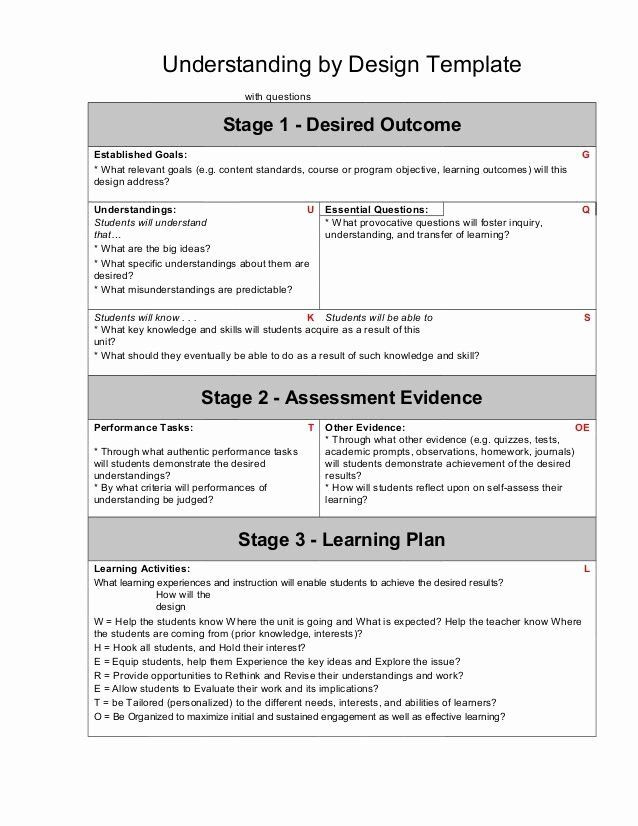Table Of Content

(Wiggins and McTighe, 2005) It is thus “backward” from traditional design because instead of starting with the content to be covered, the textbook to be used, or even the test to be passed, you begin with the goals. Besides the final assessment, teachers can gather evidence of student learning by building regular formative assessments into their lessons or units. Formative assessments can include short quizzes, peer evaluations, discussions, one-on-one student-teacher interviews and student self-reflections. The intention of these progress assessments should be to gauge abilities like critical thinking, inquiry, problem-solving and foundational knowledge as it pertains to the course content. Traditional lesson planning starts with choosing a topic (and often a book title) to teach. From there, the teacher plans out a series of lessons and activities to teach student content that falls under the umbrella of the chosen topic.

Contrast with Traditional Forward Design
Therefore, a teacher could risk omitting certain facets of the lessons from the final assessment, only acknowledging in hindsight that they probably could have saved valuable class time by skipping certain units or activities. When an assessment is created after the lessons have taken place, a teacher risks covering course content that does not add value to the overall lesson or factor into the final assessment. There are merits to both traditional lesson planning and backward lesson design, but key differences can create challenges for some teachers and students.
Traditional vs. Backward Planning
The inner circle identifies enduring understandings or big ideas that students should retain after they have forgotten many of the details (Wiggins and McTighe 1998, 9-10). The middle circle identifies what is important to know such as important knowledge (i.e, facts, concepts, and principles), as well as skills, processes, strategies, and methods. It would be easy to blow off this distinction, to say Bah, same difference. The test asks students a lot of questions that would show an understanding of these concepts, so we’re covered. The first and most important problem is a lack of durable, transferable learning. One reason so many of us don’t remember much of what we learned in school is that we learned it through this haphazard, topic-driven approach.
HOW DO I IMPLEMENT BACKWARD DESIGN IN MY COURSES?
News literacy classroom resources - News Literacy Project
News literacy classroom resources.
Posted: Mon, 23 Oct 2023 21:22:09 GMT [source]
Remember, just let your learning goal and pre-planned assessment be your guide. In other words, a superior education will teach students to think and practice like scientists. If we don’t plan learning experiences that make that possible, we’re giving them a sub-par education. Developed by Maria Montessori in the early 20th century, this method emphasizes student-directed learning in multi-age classrooms. In the Montessori approach, the teacher serves as a facilitator rather than a director of learning.
Designing Assessments of Student Learning
By aligning instructional activities with specific learning goals, educators promote meaningful progress and skill acquisition among their students. In summary, backward design offers a comprehensive and intentional approach to curriculum planning and instructional design. This framework emphasizes starting with the end goal in mind—the desired learning outcomes—before planning instructional activities and learning experiences. By focusing on big ideas and enduring understandings, educators can ensure that students engage with essential concepts and develop deep understanding. With backward design, educators have a better idea of the desired learning outcomes and can begin selecting appropriate course materials and designing instructional activities. This is where Bloom’s Taxonomy comes into play, providing a framework for categorizing learning objectives based on cognitive complexity.
Rigid Framework
I don’t wait until the final day of the semester to ask my students what their goals are for their time in my course. I ask it in the first five minutes of our initial meeting, because I want them to understand that everything we do together seeks to satisfy those goals. Applying the same process to my own lesson planning just seems like good sense.
Backward design lesson planning is a valuable approach to curriculum development that clearly focuses on learning outcomes, aligns assessments with desired results, and engages students in meaningful learning experiences. By starting with the end goal in mind, teachers can ensure that their curriculum is purposeful and effective in helping students achieve their learning goals. It ensures alignment between learning goals, assessments, and instructional activities, leading to a more coherent and purposeful learning experience for students. Backward design emphasizes the importance of focusing on essential concepts and enduring understandings, helping students develop deep understanding rather than superficial knowledge.
How to Master the Backward Lesson Planning Approach
Knowing this goal helps learners actively construct the knowledge required to achieve it. By focusing on the end goals you want to achieve, then emphasizing assessment types and content, you ensure that your lessons will always teach students what they need to know to pass tests. Depending on your class and what you teach, you may have multiple assessments throughout the course or just one at the very end. If you have just a final assessment, make sure that you model teaching tactics or learning activities toward that test as much as possible. Think explicitly about how to organize your content logically given your course subject matter. Possibilities include sequencing it chronologically, around key themes, from simple to complex disciplinary skills, from theory to application, and so on.
Backwards Design Step Three: Learning Strategies / Activities
You want to treat writing learning outcomes as an iterative process so that you get better and better at it over time. One cannot plan curriculum and build learning products without clearly defining the expectations and outcomes for our students. This happens too often and students experience the disconnect between the material and their results feeling lost and or confused because the expectations do not match up. With this detailed set of ILOs, we see exactly how the three general ILOs in the first section will be measured. Relatively immeasurable outcomes (e.g., “Gain an appreciation…”) are analyzed into the homework and exam tasks through which students can show that they have gained such an appreciation. This second set of ILOs also provides much more detail, specificity, and measurability.

To gauge effectiveness and find evidence of learning, you’ll need to plan regular mini-assessments throughout the course of a unit or lesson. Academic standards usually provide the best direction for educational goals. For example, according to the Common Core Standards for Mathematical Practice, students should be able to understand the concept of ratios by the end of sixth grade. It is the teacher’s job to determine, via backward lesson design, how their students will reach the necessary level of proficiency. While we might call Understanding by Design “backwards planning,” it doesn’t feel backward at all.
Bloom’s Taxonomy is a great tool in helping to identify action verbs appropriate for measurement. (16 PD Hours) This course will teach you the different types of assessments, how to design effective and targeted assessment items, and how to build a detailed plan for your content area and grade-level to measure student progress. Like I did, you probably also have some favorite lessons and activities. Some of these might turn out to be not just fun to teach, but also solid in terms of equipping students with knowledge and skills that will last.
While it can be difficult to grasp at first, backward design encourages educators to be intentional with their lesson planning, since it imbues the class time with a specific purpose. Normally, or with traditional lesson planning, you focus on standards and learning objectives. Design your tests and assessments first, then figure out your lesson plans, then teach your students. In backward design, educators start by identifying or creating a final assessment, then building their lessons toward that specific end.

No comments:
Post a Comment